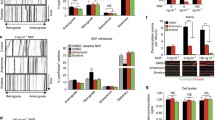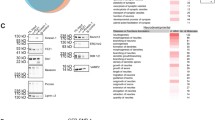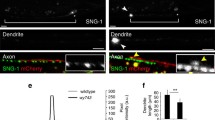Abstract
The retrograde transport of endosomes within axons proceeds with remarkable uniformity despite having to navigate a discontinuous microtubule network. The mechanisms through which this navigation is achieved remain elusive. In this report, we demonstrate that access of SxIP motif proteins, such as BPAG1n4, to the microtubule plus end is important for the maintenance of processive and sustained retrograde transport along the axon. Disruption of this interaction at the microtubule plus end significantly increases endosome stalling. Our study thus provides strong insight into the role of plus-end-binding proteins in the processive navigation of cargo within the axon.




Similar content being viewed by others
References
Hirokawa N, Niwa S, Tanaka Y (2010) Molecular motors in neurons: transport mechanisms and roles in brain function, development, and disease. Neuron 68:610–638
De Vos KJ, Grierson AJ, Ackerley S, Miller CCJ (2008) Role of axonal transport in neurodegenerative diseases. Annu Rev Neurosci 31:151–173
Akhmanova A, Steinmetz MO (2008) Tracking the ends: a dynamic protein network controls the fate of microtubule tips. Nat Rev Mol Cell 9:309–322
Dixit R et al (2009) Microtubule plus-end tracking by CLIP-170 requires EB1. Proc Natl Acad Sci USA 106:492–497
van der Vaart B et al (2011) SLAIN2 links microtubule plus end-tracking proteins and controls microtubule growth in interphase. J Cell Biol 193:1083–1099
Honnappa S et al (2009) An EB1-binding motif acts as a microtubule tip localization signal. Cell 138:366–376
Li S et al (2002) Crystal structure of the cytoskeleton-associated protein glycine-rich (CAP-Gly) domain. J Biol Chem 277:48596–48601
Slep KC et al (2005) Structural determinants for EB1-mediated recruitment of APC and spectraplakins to the microtubule plus end. J Cell Biol 168:587–598
Lomakin AJ et al (2009) CLIP-170-dependent capture of membrane organelles by microtubules initiates minus-end directed transport. Dev Cell 17:323–333
Lloyd TE et al (2012) The p150Glued CAP-Gly domain regulates initiation of retrograde transport at synaptic termini. Neuron 74:344–360
Moughamian AJ, Holzbaur ELF (2012) Dynactin is required for transport initiation from the distal axon. Neuron 74:331–343
Schuster M et al (2011) Controlled and stochastic retention concentrates dynein at microtubule ends to keep endosomes on track. EMBO J 30:652–664
Moughamian AJ, Osborn GE, Lazarus JE, Maday S, Holzbaur ELF (2013) Ordered recruitment of dynactin to the microtubule plus-end is required for efficient initiation of retrograde axonal transport. J Neurosci 33:13190–13203
Liu J-J et al (2003) BPAG1n4 is essential for retrograde axonal transport in sensory neurons. J Cell Biol 163:223–229
Liu J-J et al (2007) Retrolinkin, a membrane protein, plays an important role in retrograde axonal transport. Proc Natl Acad Sci USA 104:2223–2228
Kapur M et al (2012) Calcium tips the balance: a microtubule plus end to lattice binding switch operates in the carboxyl terminus of BPAG1n4. EMBO Rep 13:1021–1029
Barth AIM, Siemers KA, Nelson WJ (2002) Dissecting interactions between EB1, microtubules and APC in cortical clusters at the plasma membrane. J Cell Sci 115:1583–1590
Lois C, Hong EJ, Pease S, Brown EJ, Baltimore D (2002) Germline transmission and tissue-specific expression of transgenes delivered by lentiviral vectors. Science 295:868–872
Taylor AM et al (2005) A microfluidic culture platform for CNS axonal injury, regeneration and transport. Nat Method 2:599–605
Stepanova T et al (2003) Visualization of microtubule growth in cultured neurons via the use of EB3-GFP (end-binding protein 3-green fluorescent protein). J Neurosci 23:2655–2664
Cui B et al (2007) One at a time, live tracking of NGF axonal transport using quantum dots. Proc Natl Acad Sci USA 104:13666–13671
Lalli G, Schiavo G (2002) Analysis of retrograde transport in motor neurons reveals common endocytic carriers for tetanus toxin and neurotrophin receptor p75NTR. J Cell Biol 156:233–239
Mimori-Kiyosue Y, Shiina N, Tsukita S (2000) The dynamic behavior of the APC-binding protein EB1 on the distal ends of microtubules. Curr Biol 10:865–868
Hammond JW et al (2010) Posttranslational modifications of tubulin and the polarized transport of Kinesin-1 in neurons. Mol Biol Cell 21:572–583
Nakata T, Yorifuji H (1999) Morphological evidence of the inhibitory effect of taxol on fast axonal transport. Neurosci Res 35:113–122
Sun D, Leung CL, Liem RK (2001) Characterization of the microtubule binding domain of microtubule actin crosslinking factor (MACF): identification of a novel group of microtubule associated proteins. J Cell Sci 114:161–172
Dixit R, Ross JL, Goldman YE, Holzbaur ELF (2008) Differential regulation of dynein and kinesin motor proteins by tau. Science 319:1086–1089
Mudrakola HV, Zhang K, Cui B (2009) Optically resolving individual microtubules in live axons. Structure 17:1433–1441
Ross JL, Shuman H, Holzbaur ELF, Goldman YE (2008) Kinesin and dynein-dynactin at intersecting microtubules: motor density affects dynein function. Biophys J 94:3115–3125
Acknowledgments
We would like to thank W. J. Nelson for sharing constructs and S. A. Leal-Ortiz and C. C. Garner for assistance with lentivirus production. This work was supported by grants from the National Institutes of Health (NIH R01), March of Dimes foundation, and Stanford Graduate fellowship (M.K.).
Author information
Authors and Affiliations
Corresponding author
Additional information
M. Kapur, M. T. Maloney contributed equally.
Electronic supplementary material
Below is the link to the electronic supplementary material.
Rights and permissions
About this article
Cite this article
Kapur, M., Maloney, M.T., Wang, W. et al. A SxIP motif interaction at the microtubule plus end is important for processive retrograde axonal transport. Cell. Mol. Life Sci. 71, 4043–4054 (2014). https://doi.org/10.1007/s00018-014-1611-6
Received:
Revised:
Accepted:
Published:
Issue Date:
DOI: https://doi.org/10.1007/s00018-014-1611-6




